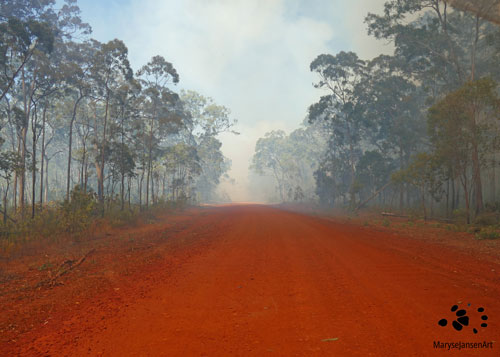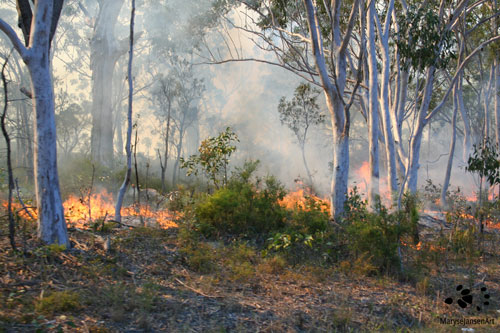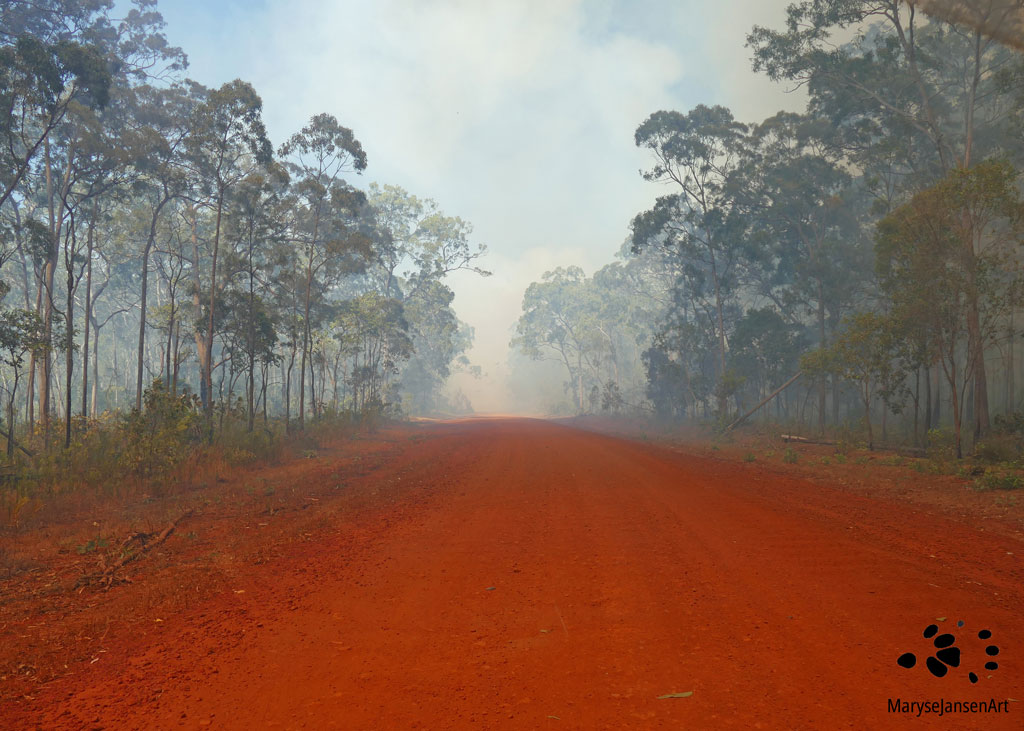Landscape Photography by marysejansenart
The difference between Wildfires, Hazard Reduction Burns and Cool Burns

Table of Contents
Bushfire
Driving on an outback road I have to turn around because of a bushfire. But not before I take this photo. The scene has an incredible beauty with the deep red dirt, lined by the trees in a haze of smoke. When you look really, really closely in the centre of the image you might notice a Black Kite. These raptors hang out at the edge of the fire, waiting to ambush prey that comes fleeing out of the smoke…
When you live in Australia bushfires are a common occurrence. They can be very dangerous and destructive. But they can also be a good thing, keeping us and wildlife safe and even aid conservation of natural areas. How is that possible??
It is important to recognise that there are different types of bushfires: wildfires, hazard reduction fires and cool burns. Let’s have a look at each of these.
Wildfires
I think we will all remember vividly the bush fires during the summer of 2019-2020. Millions of hectares of land burned down throughout New South Wales, Victoria, Queensland, ACT, Western Australia and South Australia. Even though I was thankfully not in any direct danger from the fire itself, the immensely thick layer of smoke in the air that hung around for an extended period of time was a serious problem. It was very hot weather but we had to keep all windows and doors closed at all times, I could barely breathe when I was outside.
Over a billion animals died (and that is excluding hundreds of billions of insects which also lost their lives), many threatened and endangered species losing significant numbers and habitat. It was a true natural disaster….
When the land is dry, things like dry grasses and leaf litter serve as fuel for fires, igniting and burning easily so that fires can get hot, grow high flames and spread very quickly. These fires are very difficult to get under control as we have seen in this event. They are very destructive and leave the land blackened, barren and lifeless.
Hazard Reduction Burns and Fire Breaks
In order to prevent wildfires from spreading, hazard reduction fires have been put into place. In Queensland these burns are usually conducted by Queensland Parks and Wildlife Service and Partnerships or local councils. The main objective of Hazard Reduction Burns is to protect the community from wildfires, keep people safe and protect the infrastructure.
The aim is to remove the dry vegetation and leaf litter on the ground of forests, bushlands and grasslands, which serves as fuel for the fires. By keeping these burns under control the trees remain intact which should help the local ecology recover. Wildfires can still get through an area after a burn but as the fuel load is so much less, the wildfires will be less intense and move more slowly. It gives firefighters a chance to get them under control.
Fire breaks, or fire management lines are also a common practice. These are up to 10m wide constructed lines, cleared of vegetation. It’s best a straight line and well maintained. They are used to be able to get away from fires or get access to fires, and to get to water. People that live in the bush can also clear a fire break around their property, to help keep fires at a distance.
Can you imagine that finding the ‘sweet spot’ in weather conditions to do these Hazard Reduction Burns is quite challenging? It has to be hot and dry enough for the fuel to burn, but not so much that the fire gets out of control…. It’s a balancing act!
And even when the burns have been successfully executed, it doesn’t always work so well… When the weather is dry, hot and windy the wildfires can get still out of hand and find their way to spread through the tree tops. Catastrophic wildfires have really high flames and can ‘jump’ firebreaks easily as well.

Back Burning is another term that is often confused with Hazard Reduction Burning. The difference is that Hazard Reduction Burning is a preventative measure, while Back Burning is used to manage existing wildfires and reduce fuel load in the area that the fire is heading towards.
Some plants and trees like or even need fire
You may have heard that certain plants and trees need fire for their seeds to be able to germinate?
Firstly, the heat of the fire helps certain seeds to crack open to enable them to germinate. And secondly, certain chemicals in the smoke from the bushfires trigger the seeds to germinate. Examples of fire dependent native plants and trees are Wattles, Banksias and Kangaroo Paw.
Conventional hazard reduction burning has been used for over a century now but it is often still too hot and will cook or bake seeds instead of help them germinate. When the fire is too hot it can do a lot of damage to the ground. It will destroy the seeds and nutrients that are in the top layer of the dirt.
Another problem is that after hotter fires, the vegetation that tends to survive and grow back ‘likes’ hot fires, thus increasing the chance of more wildfires.
Examples are the Lantana bush, the Bracken Fern and the Casuarina (She-oak). Lantana is an invasive weed, and really not something we want to be growing back. Bracken Fern and Casuarina are natives but they both carry extreme fuel loads. They absolutely belong in the landscape but should not be dominating it.
The Bracken Fern can really act invasive if given the chance like in these situations. It then spreads quickly, chokes the ground and leaves no space for other plants like grasses, herbs and shrubs to grow. You can see that after hot fires, certain species of vegetation take advantage and as a consequence there is a decline in biodiversity in these areas.
Cool Burns or Cultural Burns
Thankfully there is a solution for these problems and it is thousands of years old! It is called Cool Burning. For thousands of years Aboriginal people have used cool burning techniques to look after the land, to protect and regenerate it.
Cool burning is a lot more hands on then a Hazard Reduction Burn. It uses only small blazes of fire, carefully managed to stay low and cool, to clear the underbrush. Like Hazard Reduction Burns it also helps to keep the community safe but it has a much broader objective, which is that of looking after the land through the maintenance and regeneration of valuable ecosystems.
It helps stimulate regrowth of herbs and grasses, a great variety of plants, including bush tucker plants and medicine plants. The burns are performed in a mosaic pattern so that wildlife has escape routes. The tree canopy is preserved so that there is shade on the ground for new life to grow and the habitat for tree dwelling animals is protected.
This technique is also called Cultural Burning because a lot of knowledge has been passed on in the Indigenous culture about looking at the land and knowing the right moment to burn, which is different for each place and each ecosystem.
Early settlers did not understand the function and importance of the fires that the Aboriginal people created and saw the fires as a threat. Under theirs and subsequent regimes ecosystems have degraded such that nowadays large parts of the country are at risk of wildfires.
Today, Australian governments – including the Queensland Parks and Wildlife Service – are looking more and more to the Aboriginal community to collaborate, learn from and implement their fire management practices to help restore the land and reduce wildfires.
If you are interested in purchasing ‘Outback Road into Bush Fire’ or would like to see what the image looks like on the various products, please head to my shop.
In my latest episode of ‘Come for a walk in the Australian Bush’ we go for a walk in the Glass House Mountains and we will see the effects of a very recent Hazard Reduction Burn.


